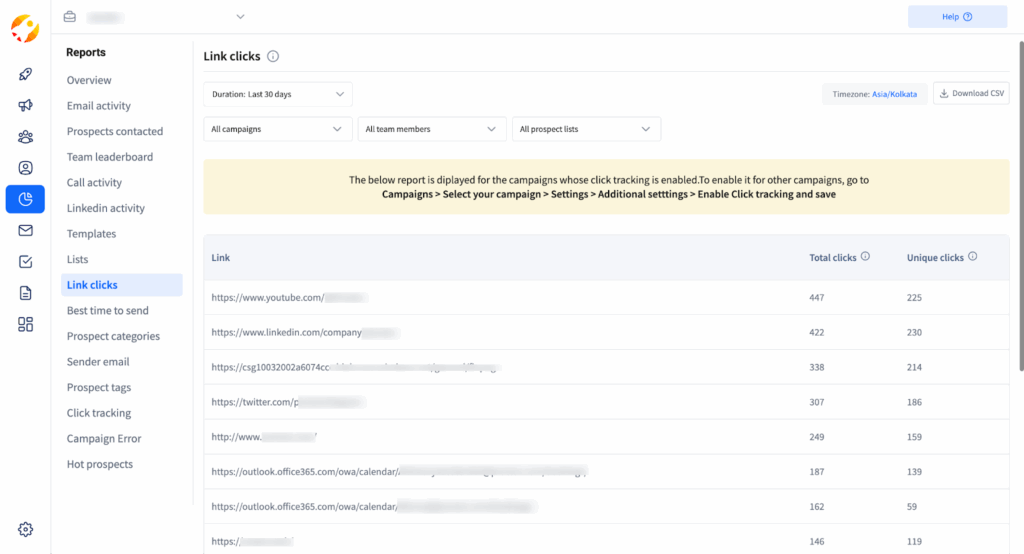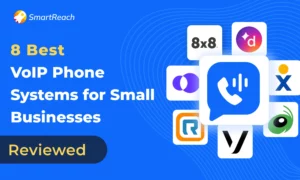How to Calculate Conversion from Click-Through Rates in Email Reports
For cold emailers, it’s a win when prospects click links inside your campaigns.
But the real question is: are those clicks turning into conversions?
Finding the connection between click-through rate (CTR) and conversions is one of the most practical ways to evaluate whether your emails are generating real results like demo bookings, trial sign-ups, or replies.
Even more importantly, CTR data gives you clues about which CTAs in your emails need improvement.
In this guide, we’ll exactly find that out.
TL;DR – Everything you need to know about cold email CTR
- CTR shows initial interest but conversions prove impact.
- Use the CTR formula to calculate clicks vs. delivered emails.
- Track how many of those clicks turn into conversions (demo, signup, purchase).
- Refine your CTAs using performance data.
- Use SmartReach.io’s Link Clicks Report to automate tracking and make smarter decisions.
What is CTR in the context of cold email?
CTR is the percentage of people who clicked a link in your email compared to the number of people who opened or received the email. It’s the first step in connecting engagement to actual conversions.
CTR Formula
The basic formula for calculating CTR is:
| CTR (%) = (Total Link Clicks ÷ Total Delivered Emails) × 100 |
For example: If you send 1,000 emails, 600 are delivered, and 30 people click on your link, your CTR is:
| CTR = (30 ÷ 600) × 100 = 5% |
A 5% CTR means 5% of delivered emails generated a click. But clicks are just the start; you need to dig deeper into conversion.
Does CTR actually matter for cold email campaigns?
For cold email campaigns, CTR is an especially important metric because:
- Campaign prospects are usually not familiar with you yet. A click signals curiosity or intent.
- CTR helps identify which value propositions or CTAs resonate most.
- It provides a leading indicator for downstream conversions like sign-ups or demos.
But here’s the nuance: CTR doesn’t equal conversion from an email campaign.
You could have a high CTR but a low conversion rate if your landing page, offer, or CTA isn’t aligned with prospect expectations.
How to find out the conversion from link clicks in email campaigns?
Clicks show interest. Conversions show intent.
To calculate conversion from CTR, you need to connect clicked links with downstream actions.
Step 1) Define your conversion goal in the campaign
A “conversion” will look different depending on the goal of your cold email campaign. Examples include:
- Booking a product demo (which we do in our campaigns)
- Signing up for a free trial
- Registering for a webinar
- Downloading a whitepaper
- Replying with interest (for high-touch campaigns)
Without a clear definition, you can’t measure conversion effectively.
Step 2) Measure conversions from clicks
Clicks are mid-funnel.
Once you know your conversion goal, measure how many people who clicked actually completed the action.
To turn CTR into conversions, track what happens after the click:
- Use UTM parameters on links to connect clicks to Google Analytics or CRM records.
- Link your email platform or automation platform with a CRM to log actions.
- Track if the landing page has a form fill, sign-up, or booking completion.
Example: Out of 45 clicks in a campaign, only 12 filled out the “Book a Demo” form.
Some email automation platforms, like SmartReach.io provides built-in link click reports.

*Link click report inside a SmartReach.io campaign
This link click report shows the number of times links in your email content were clicked. This includes:
- Links in the body of your email (e.g., booking links, trial sign-ups).
- Links in your email signature (e.g., website or contact info).
- Campaign-level and account-level visibility, so you can spot trends.
By combining CTR data from SmartReach.io’s Link Clicks Report with your conversion tracking (like demo bookings or CRM data), you can calculate the true conversion rate from clicks without guesswork.
You can try this feature inside SmartReach.io for free (Sign-up for a free trial)
Step 3) Layer in downstream metrics
For lead nurturing campaigns, it’s not just about one click → one conversion.
Consider the below scenarios:
- Multi-step funnels: A prospect may click a blog link, engage with content, and later sign up.
- Attribution timing: Some conversions happen days or weeks after the first click.
- Quality of conversions: A booked demo with the right decision-maker is more valuable than one with an unqualified lead.
Tracking this full funnel ensures you aren’t misled by inflated CTRs.
Step 4) Optimize the campaign based on data
Now you can optimize the elements in your site to improve the conversions from the campaign even better.
For cold email campaigns, you should:
- Benchmark CTR-to-conversion rates for each campaign (e.g., 15–30% is healthy for demo-driven B2B outreach).
- Run A/B tests on CTAs (button vs. text, placement, phrasing).
- Refine your offer: Sometimes, the CTA isn’t the problem, the offer itself is too generic.
Continuous improvement ensures you move from just tracking clicks to actually driving revenue.
Based on the results, you can take the next action ⤵️
- If CTR is high but conversions are low → your landing page or offer may be weak.
- If CTR is low → your email CTAs may not be compelling enough.
Now, if you’re absolutely uncertain if your cold email CTR data is high or low, you can always compare it with the industry averages,
For that, you can check out this dedicated article “A Complete Guide To Cold Email Conversion Rate”
Also, remember that high CTR = high Conversions all the time.
This is a trap many cold emailers fall into.
Let’s break it down with two scenarios ⤵️
- Scenario A: You get a 7% CTR, but only 5% of those clicks convert.
- Scenario B: You get a 3% CTR, but 25% of those clicks convert.
Which campaign is performing better?
Scenario B 🚀
Even though fewer people clicked, a higher proportion of them took meaningful action.
This shows why CTR is just a directional metric, not the ultimate KPI.
How to refine CTAs based CTR data from email campaigns
Your call-to-action (CTA) is the bridge between clicks and conversions from the email campaign.
If it’s weak, your CTR and conversion rates will suffer.
Here’s how to refine them using real CTR data:
Step 1) Diagnose underperforming links in the campaign
If your email has multiple links like “Book a Call” and “Visit Our Website” – check which one drives more clicks.
If one consistently underperforms, it may need rephrasing or removal.
Step 2) Optimize CTA placement inside the email
Cold emails are short.
If your CTA is buried at the bottom of the email, prospects may not see it.
Place your primary CTA above the fold, ideally after your main value proposition.
Step 3) Test multiple CTA variations
Instead of vague CTAs like “Click here”, use specific outcomes like “Book your 15-minute demo”.
❌ Weak CTA: “Click here to learn more.”
✅ Strong CTA: “Schedule a 15-min call to see how your team can reduce reply times by 40%.”
Action-oriented, outcome-driven CTAs almost always outperform generic ones.
Step 4) Personalize for lead nurturing
For lead nurturing campaigns, CTAs should feel low-friction and helpful.
Examples of some personalized CTAs for lead nurturing campaigns:
| “See how other SaaS teams in [Industry] solved this problem.” “Grab your free playbook for outbound prospecting.” |
Personalized, resource-driven CTAs tend to get higher conversions from CTR.
Using these above steps, you can refine the CTAs you use inside the email campaign.
Make sure to change/modify it based on the type of email campaign (lead gen, nurturing etc.) you are running.
F.A.Qs: cold email CTR
Q. How do I measure conversion from CTR in a cold email campaign?
Track how many prospects clicked your CTA link, then measure how many completed the intended action (demo booking, trial sign-up). Divide conversions by total clicks to get the conversion percentage.
Q. Why does my cold email get clicks but no conversions?
This usually happens when your landing page, booking form, or CTA promise doesn’t match the email’s message. Simplify the action step, make the offer clearer, and ensure the page loads fast.
Q. Which CTA works best in cold email campaigns?
CTAs that are specific, short, and low-commitment perform best. For example, “Book a 10-min call” or “See customer results in your industry” works better than vague CTAs like “Click here.”
Q. How can CTR data improve my follow-up emails?
If CTR is low, reframe your CTA to be more compelling. If clicks are high but conversions are low, refine the landing page or shorten the sign-up process. Each CTR report gives clues for the next email.
Q. Can signature links affect CTR analysis in cold email campaigns?
Yes. Signature links like a website or LinkedIn profile often attract clicks but don’t drive conversions. Use reporting tools to separate high-intent CTA clicks from signature or low-intent clicks.



